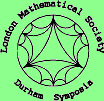|
|
LMS Durham Symposium
Computational methods for
wave propagation in direct scattering
Andreas Kirsch (Karlsruhe. Germany)
Inverse scattering theory for time-harmonic waves
Abstract
In these talks we will give an introduction to the theory
of inverse scattering theory and survey some of the more recent numerical
approaches for their solution.
Part I: An Introduction to Scattering Theory for Time-Harmonic Waves
In this first part we will give an introduction to the scattering of
time-harmonic plane waves by bounded obstacles. We will focus on the
questions of uniqueness and existence, recall the integral equation
methods and will also mention the variational approach. We will also
introduce the scattering amplitude as the first coefficient in the
Atkinson-Wilcox expansion of the scattered field.
Part II: The Scattering Amplitude and the Inverse Problem
The second part will be devoted to the corresponding inverse scattering
problem. This is the task to determine properties of the scattering
medium (e.g. the shape of the obstacle or the index of refraction) from
full or partial knowledge of the scattering amplitude. To study this problem,
more knowledge on the scattering amplitude is required such as
reciprocity principles, unitarity of the scattering matrix and normality
of the far field operator. A main part of this talk will be concerned with
the question of uniqueness of the inverse problem.
Part III: Numerical Treatment of the Inverse Scattering Problem
In this part we will first review some of the more recent iterative methods
for solving the inverse scattering problem such as the regularized
Gauss-Newton methods, the Landweber method or second-degree methods. They
are all based on an efficient way to compute the domain derivatives. Then
we will introduce a new approach to characterize the shape of the
scattering medium (either an obstacle or an inhomogeneous medium) by the
scattering amplitude which is now also known under the name ``Linear
Sampling Method''. Some numerical examples show advantages and limitations
of the methods.
|
